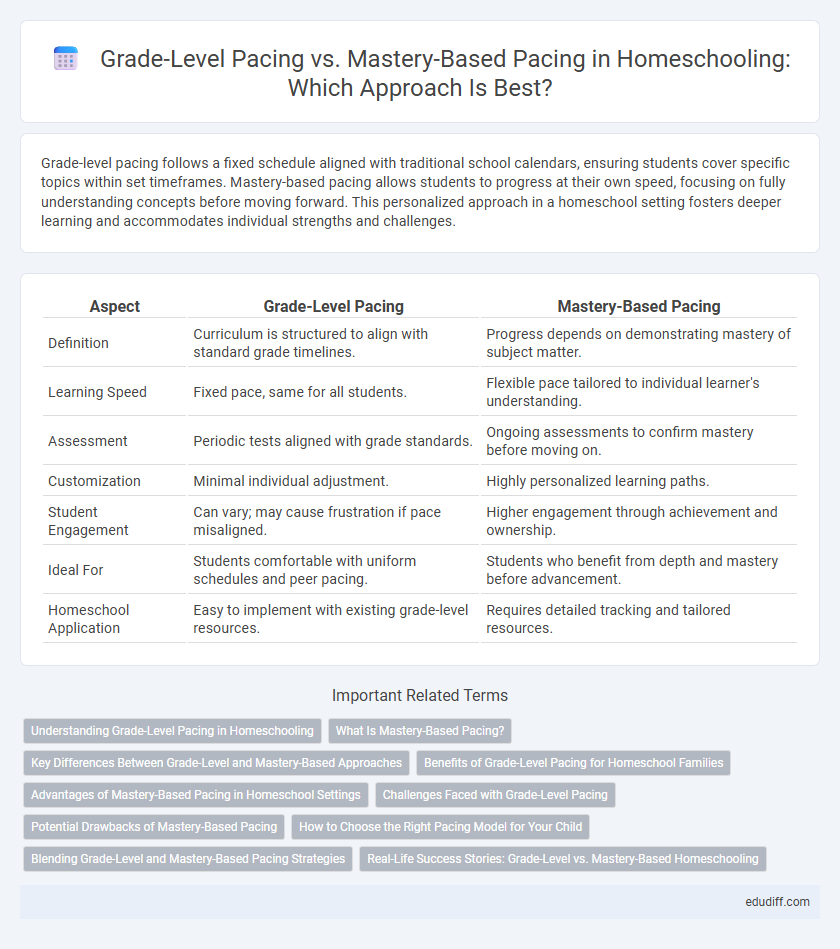Grade-level pacing follows a fixed schedule aligned with traditional school calendars, ensuring students cover specific topics within set timeframes. Mastery-based pacing allows students to progress at their own speed, focusing on fully understanding concepts before moving forward. This personalized approach in a homeschool setting fosters deeper learning and accommodates individual strengths and challenges.
Table of Comparison
| Aspect | Grade-Level Pacing | Mastery-Based Pacing |
|---|---|---|
| Definition | Curriculum is structured to align with standard grade timelines. | Progress depends on demonstrating mastery of subject matter. |
| Learning Speed | Fixed pace, same for all students. | Flexible pace tailored to individual learner's understanding. |
| Assessment | Periodic tests aligned with grade standards. | Ongoing assessments to confirm mastery before moving on. |
| Customization | Minimal individual adjustment. | Highly personalized learning paths. |
| Student Engagement | Can vary; may cause frustration if pace misaligned. | Higher engagement through achievement and ownership. |
| Ideal For | Students comfortable with uniform schedules and peer pacing. | Students who benefit from depth and mastery before advancement. |
| Homeschool Application | Easy to implement with existing grade-level resources. | Requires detailed tracking and tailored resources. |
Understanding Grade-Level Pacing in Homeschooling
Grade-level pacing in homeschooling follows a structured timeline aligned with traditional school years, ensuring that students cover core subjects according to standardized benchmarks. This approach supports consistent progress and eases transitions into formal schooling or state assessments. Understanding grade-level pacing helps parents maintain curriculum alignment while monitoring their child's readiness for each academic milestone.
What Is Mastery-Based Pacing?
Mastery-based pacing in homeschool education prioritizes student comprehension over adhering to a fixed schedule, allowing learners to progress only after demonstrating a thorough understanding of each subject area. This approach contrasts with grade-level pacing, which follows a predetermined timeline regardless of individual mastery, often leading to gaps in knowledge. Emphasizing mastery-based pacing cultivates deeper learning, critical thinking, and long-term retention by adapting to each student's unique pace and learning needs.
Key Differences Between Grade-Level and Mastery-Based Approaches
Grade-level pacing follows a standardized timeline based on age or school year, ensuring all students progress through the curriculum simultaneously, while mastery-based pacing allows learners to advance only after demonstrating a thorough understanding of each concept. In homeschooling, mastery-based pacing supports personalized learning by accommodating individual strengths and struggles, promoting deeper comprehension and retention. Key differences include flexibility in progression, emphasis on competency over time, and adaptation to student needs versus adherence to fixed schedules.
Benefits of Grade-Level Pacing for Homeschool Families
Grade-level pacing in homeschool ensures alignment with standardized academic expectations, promoting consistency and ease of tracking progress through nationally recognized benchmarks. This structured timeline helps families maintain a balanced curriculum, providing clear goals and measurable outcomes that support timely grade completion. It also facilitates smoother transitions into traditional schools or standardized testing environments by adhering to widely accepted educational standards.
Advantages of Mastery-Based Pacing in Homeschool Settings
Mastery-based pacing in homeschool settings allows students to progress only after fully understanding a concept, which ensures deeper comprehension and long-term retention. This approach accommodates individual learning speeds and styles, reducing frustration and increasing motivation. Homeschoolers benefit from personalized learning plans that prioritize skill mastery over rigid timelines, leading to more effective educational outcomes.
Challenges Faced with Grade-Level Pacing
Grade-level pacing in homeschool often presents challenges such as students feeling rushed to cover extensive curricula before fully understanding core concepts, leading to gaps in foundational knowledge. This rigid timeline can cause increased stress and decreased motivation as learners struggle to keep up with standardized benchmarks rather than focusing on individual comprehension. In contrast, mastery-based pacing allows for personalized learning speed, minimizing frustration and promoting deeper mastery of subjects.
Potential Drawbacks of Mastery-Based Pacing
Mastery-based pacing in homeschooling may lead to extended time on certain subjects, potentially causing boredom or disengagement in students eager to progress. It can also create scheduling challenges for families balancing multiple grade levels or activities. Limited standardized benchmarks might result in gaps when transitioning to traditional schools or higher education.
How to Choose the Right Pacing Model for Your Child
Selecting the right pacing model for your child in homeschooling depends on their individual learning style and developmental needs. Grade-level pacing follows a structured timeline based on age, ensuring coverage of standardized curriculum milestones, while mastery-based pacing allows students to progress upon demonstrating full comprehension, promoting deeper understanding. Assess your child's strengths, motivation, and attention span to determine whether a flexible mastery approach or a traditional grade-level schedule will optimize their academic growth and engagement.
Blending Grade-Level and Mastery-Based Pacing Strategies
Blending grade-level pacing with mastery-based pacing in homeschool fosters a tailored learning experience that aligns with each student's unique progress while meeting standardized benchmarks. This hybrid approach integrates curriculum milestones with flexible timing, allowing learners to master essential skills before advancing, thereby preventing gaps in knowledge. Utilizing diagnostic assessments and adaptive scheduling, parents can optimize educational outcomes by balancing structured objectives and individualized mastery.
Real-Life Success Stories: Grade-Level vs. Mastery-Based Homeschooling
Real-life success stories reveal that mastery-based homeschooling often leads to deeper understanding and long-term retention compared to grade-level pacing, which focuses on advancing with peers regardless of mastery. Families practicing mastery-based pacing report increased learner confidence and individualized progress, especially in subjects like math and reading. Case studies highlight students mastering critical skills before moving on, resulting in greater academic resilience and adaptability in higher education and career challenges.
grade-level pacing vs mastery-based pacing Infographic

 edudiff.com
edudiff.com